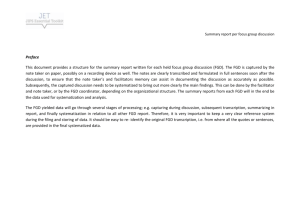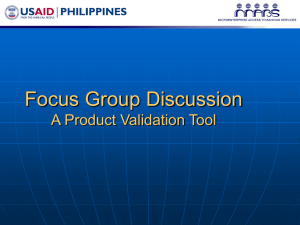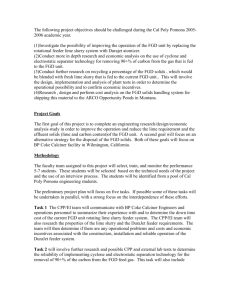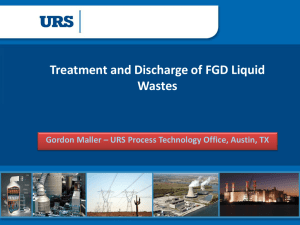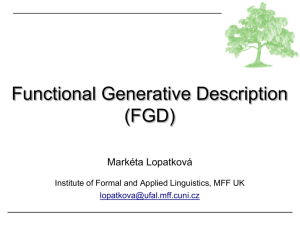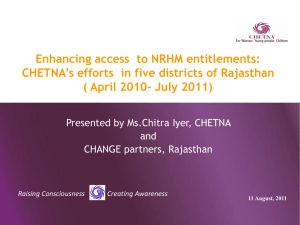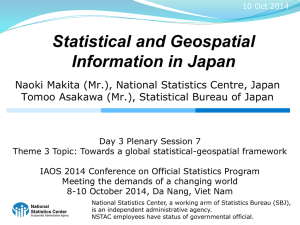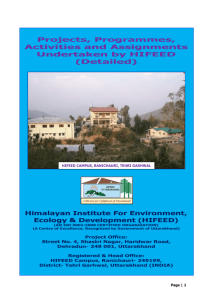Tool/Methodology for Monitoring Policy Implementation
advertisement
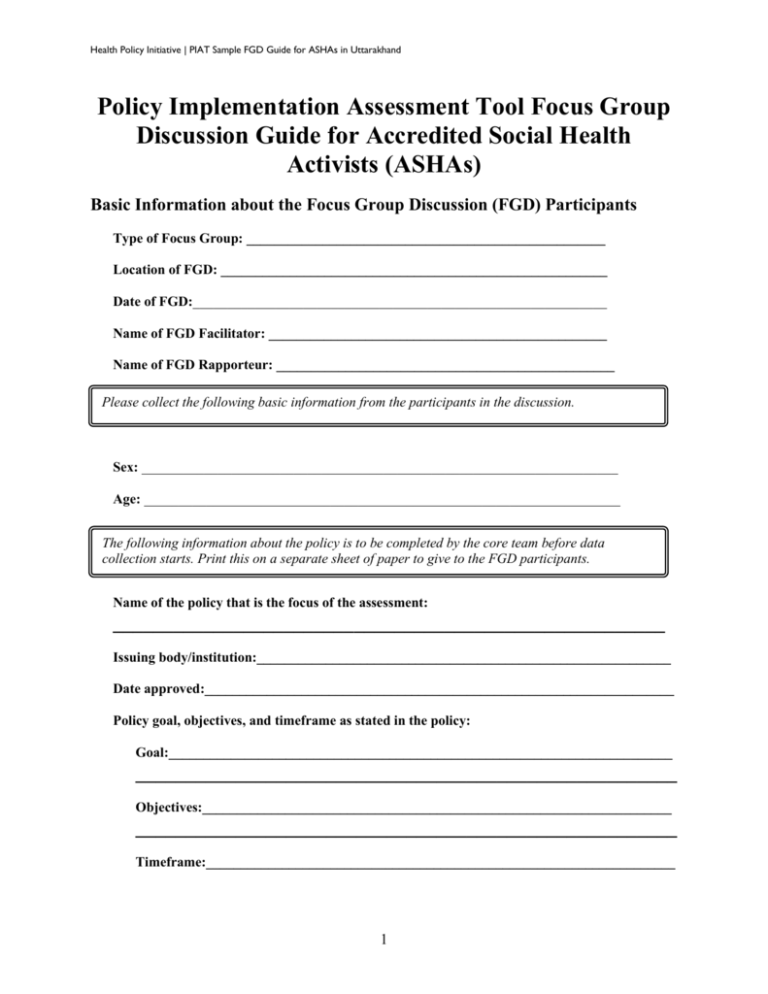
Health Policy Initiative | PIAT Sample FGD Guide for ASHAs in Uttarakhand Policy Implementation Assessment Tool Focus Group Discussion Guide for Accredited Social Health Activists (ASHAs) Basic Information about the Focus Group Discussion (FGD) Participants Type of Focus Group: ____________________________________________________ Location of FGD: ________________________________________________________ Date of FGD:____________________________________________________________ Name of FGD Facilitator: _________________________________________________ Name of FGD Rapporteur: _________________________________________________ Please collect the following basic information from the participants in the discussion. Sex: _____________________________________________________________________ Age: _____________________________________________________________________ The following information about the policy is to be completed by the core team before data collection starts. Print this on a separate sheet of paper to give to the FGD participants. team before data collection starts. . Name of the policy that is the focus of the assessment: _______________________________________________________ Issuing body/institution:____________________________________________________________ Date approved:____________________________________________________________________ Policy goal, objectives, and timeframe as stated in the policy: Goal:_________________________________________________________________________ ______________________________________________________ The following is to be completed by the core team before data collection starts. Print this on a separate sheet of paper to give to the respondent. . Objectives:____________________________________________________________________ ______________________________________________________ Timeframe:____________________________________________________________________ 1 Health Policy Initiative | PIAT Sample FGD Guide for ASHAs in Uttarakhand Note to Facilitator and Note Taker: Please establish a comfortable environment for the FGD. The participants should feel free to discuss the information and need to know that the information they offer will not be attributed to any individual. Please help them understand how important their opinions are to the research team and the policymakers who are interested in hearing their opinions. All instructions to interviewers are italicized and enclosed by double-lined boxes. They should not be read aloud. All questions or phrases to read aloud are in bold font. Many questions are open-ended; most questions request the participants to specify or explain further. Please probe appropriately to obtain the underlying reasons. Write down any comments or recommendations that the participants give. Interviewers are encouraged to probe in the case of open-ended questions. If possible and acceptable to the participants, record the FGD proceedings for future reference. Differences of opinion are expected. There should be no attempt to reach consensus among the participants. Numbered categories of responses are provided for one question. Read out the categories to the respondent and indicate the number of participants with the respective choices. In some instances, one or more respondents may decline to answer a specific question. If so, write down “declined” as appropriate. Then ask the respondents if it is okay to ask the next question. In case questions arise, make sure you have a copy of the policy with you. If applicable, explain how participants will be compensated for travel expenses, etc. Introduction Please read aloud or modify as necessary. . Namaste! Thank you all very much for taking part in this focus group discussion. My name is state your name and I work for state your organization. This is state note taker’s name, who will be taking notes during our discussion today. The state government of Uttarakhand has taken the decision to review the state Health and Population Policy with the objective of understanding the implementation process of various programs and to identify areas for strengthening the quality of healthcare services for the people of Uttarakhand. For this review we are interviewing implementers and stakeholders regarding the implementation of the state Heath and Population Policy of Uttarakhand. To gather relevant information, we are meeting with various people to get feedback on how you think the services related to this policy are being implemented. The purpose of this assessment is to analyze how well the health and population programs are being implemented in your area. The results of this focus group discussion, as well as many other interviews with other people, will be 2 Health Policy Initiative | PIAT Sample FGD Guide for ASHAs in Uttarakhand used by decisionmakers and others responsible for implementation in insert geographic area to address problems and improve services. To guide our discussion today, I will ask a series of questions. As key issues arise, I may also ask follow-up questions to the group. Everyone’s viewpoints are valuable, so I encourage you all to speak up and share your thoughts. There is no need to come to consensus on any answer. We have scheduled enter time allotted for our discussion today. CONSENT Before we get started, please be assured that all your responses will be held in strict confidence. Findings will be presented in summary, and no statements or quotes used in the report will be attributed directly to you. Your participation is voluntary, and you may decline to answer any question or leave the discussion at any point. We would like to audio tape the whole discussion for our reference and assure you that the tapes will be destroyed once we prepare the notes from it. Do you agree to continue? ___Yes (# ) ____________Facilitator’s Initials ___No (# ) A. The Policy, Its Formulation, and Dissemination A1. Have you heard about the state health and population policy of Uttarakhand? A2. If yes, how did you become aware of the policy? Distribute the summary of the policy and review the key points. A3. What are the major programs/schemes related to health and population in your area? A4. Do you think these programs address the main health problems and needs in the community? 3 Health Policy Initiative | PIAT Sample FGD Guide for ASHAs in Uttarakhand A5. How do you get information about these programs? A6. Is the information that is provided sufficient? If not, please suggest ways in which the information can reach you more effectively. B. Social, Political, and Economic Context The core team should tailor the questions in this section to include any specific social, economic, or political issues that may affect policy implementation. B1. From your perspective, what social norms—such as religious/cultural practices or beliefs, roles for men and women, ethnic status or social status—hinder or facilitate access to healthcare services? How do these norms affect different groups, such as women, single women, married women, men, adolescents, indigenous groups, rural groups, and the poor, in accessing services? Social Factor (1) Facilitate/Hinder (2) Describe Effect (B1a) Religious practices or beliefs (B1a1) (B1a2) (B1b) Gender norms (B1b1) (B1b2) (B1c) Cultural practices (B1c1) (B1c2) (B1d) Ethnic affiliations (B1d1) (B1d2) 4 Health Policy Initiative | PIAT Sample FGD Guide for ASHAs in Uttarakhand (B1e) Social status (B1e1) (B1e2) (B1f) Other (B1f1) (B1f2) B2. How do political factors—such as changes in government or other local or national policies/politics —hinder or facilitate access to healthcare services? Political Factor (1) Facilitate/Hinder (2) Describe Effect (B2a) Changes in government (B2a1) (B2a2) (B2b) Local political issues (B2b1) (B2b2) (B2c) National political issues (B2c1) (B2c2) (B2d) Other (B2d1) (B2d2) 5 Health Policy Initiative | PIAT Sample FGD Guide for ASHAs in Uttarakhand B3. What do you think are the other factors which hinder or facilitate people in accessing healthcare services in your area? Consider economic factors, such as unemployment, migration, poverty, roads and transportation, and cost of living. Economic Factor (1) Facilitate/Hinder (2) Describe Effect (B3a) Unemployment (B3a1) (B3a2) (B3b) Migration (B3b1) (B3b2) (B3c) Poverty (B3c1) (B3c2) (B3d) Cost of living (B3d1) (B3d2) (B3e) Other (B3e1) (B3e2) C. Leadership for Policy Implementation C1. What are your roles and responsibilities in implementation of various programs on health and population? 6 Health Policy Initiative | PIAT Sample FGD Guide for ASHAs in Uttarakhand C2. Are there influential groups that support implementing these programs? C3. Are there other influential groups that oppose implementing these programs? C4. Is there a Health and Sanitation Committee/or any other committee formed in your village? What role does the committee play in implementation of health programs? C5. What role do you think the pradhans play in health programs of the village? D. Stakeholder Involvement D1. Which are the other departments or NGOs you work with to help implement the health programs? Probe to get information on ICDS/Drinking Water. D2. What kind of coordination takes place with these departments and NGOs at the community level? D3. What do you think are some of the ways to improve coordination and linkages with them to increase access to health services? D4. Do you think there are other groups/institutions in your area that should be involved in implementation of programs and are currently not involved now? Please identify and explain why their participation would foster implementation. 7 Health Policy Initiative | PIAT Sample FGD Guide for ASHAs in Uttarakhand E. Implementation Planning and Resource Mobilization E1. Can you describe new resources/programs/schemes on issues of health, which have been launched in the last 2-3 years? Probe JSY, fee exemption, mobile vans Probe JSY, fee exemption, mobile vans, etc. E2. What is your role in facilitating people’s access to these programs? What was your experience? E3. What was the nature of trainings provided to help you understand and implement the programs? E4. Do you think the trainings were sufficient in terms of issues covered and quality? E5. Do you think there are new areas you would want to get trained on? E6. Do you get any special aids (e.g., reference material, weighing machine) for implementing programs? E7. What kind of program-related resources will help you strengthen implementation? 8 Health Policy Initiative | PIAT Sample FGD Guide for ASHAs in Uttarakhand F. Operations and Services F1. In case there are changes or additions in the existing programs, do you receive information about these? F2. If yes, how did you hear about the changes? F3. In the last 2-3 years, what, if any, positive changes have you noticed in terms of access to healthcare services. Consider the availability of staff, hours of operation, affordability of services, geographic access to services, and availability of commodities, among others. F4. In the last 2-3 years, what, if any, positive changes have you noticed in terms of quality of healthcare services. Consider things such as: access to appropriate information, quality of counseling, and adequacy of staff training, among others. F5. What do you see as the main challenges/barriers to providing services in your areas? F6. What do you see as the main challenges/barriers in people accessing services in your areas? G. Feedback on Progress and Results G1. Do you have feedback meetings with ANMs or NGO supervisors about how the services are being implemented? G2. From your experience, are ANMs and NGO supervisors able to help with solutions to your challenges in providing services? Please explain. 9 In this section, please Health Policy Initiative | PIAT Sample FGD Guide for ASHAs in Uttarakhand double check that the G3. responses Who do you think should be involved in monitoring these services? refer to activities under the policy, not the organization H. Overall Assessment in general. H1. Overall, how well do you think the healthcare services are being implemented? 1 Not being implemented 2 Partly implemented 3 Many parts of the policy are being implemented (H1a) Please explain. H2. What would improve healthcare services in your community? H3. Does anyone have any additional comments or suggestions? Thank you. 10 4 Overall, implementation is proceeding very well
